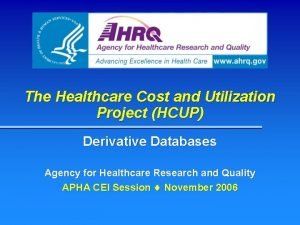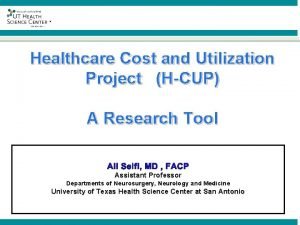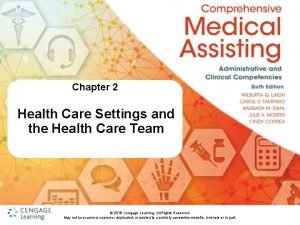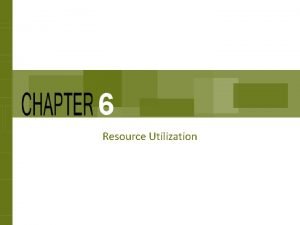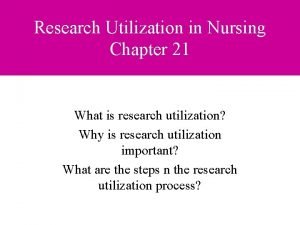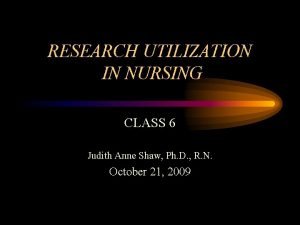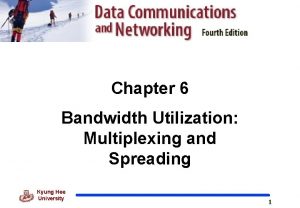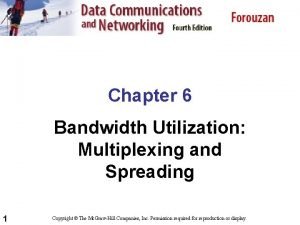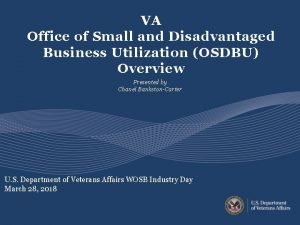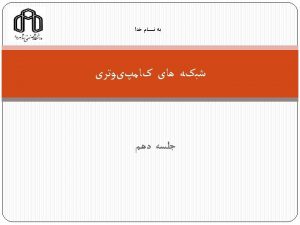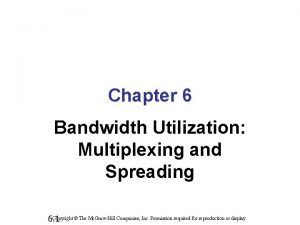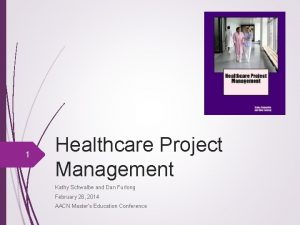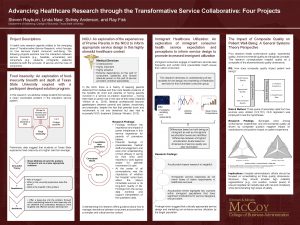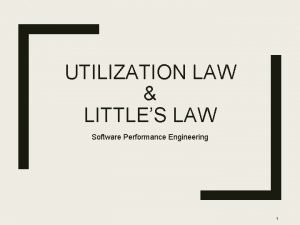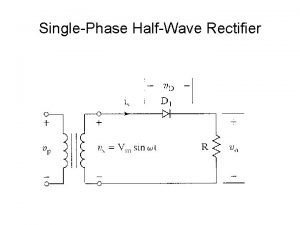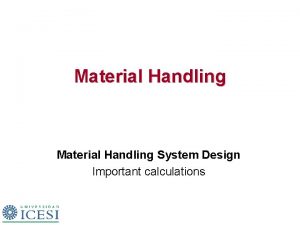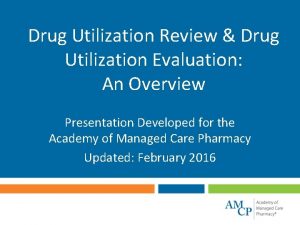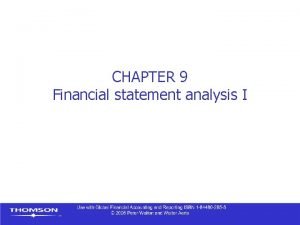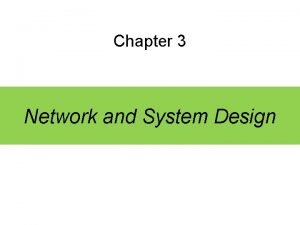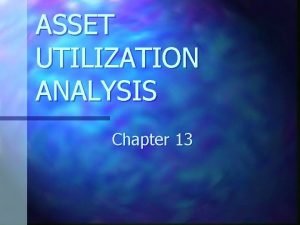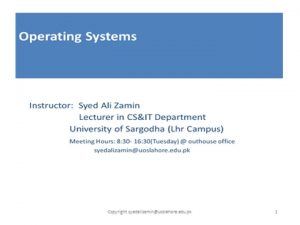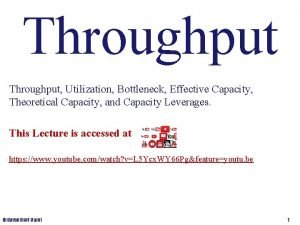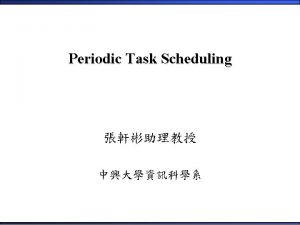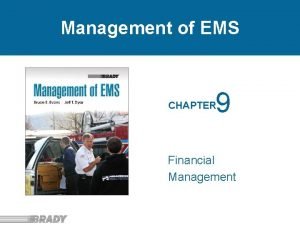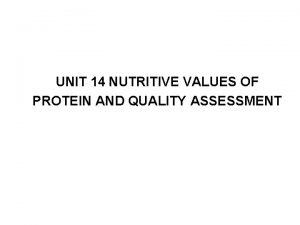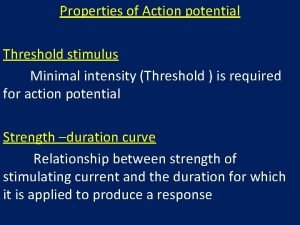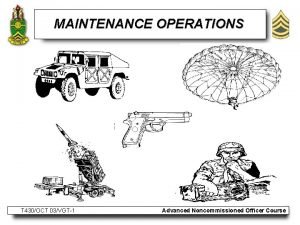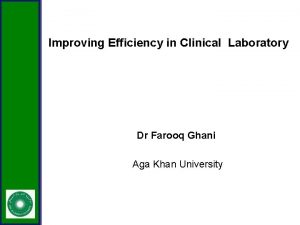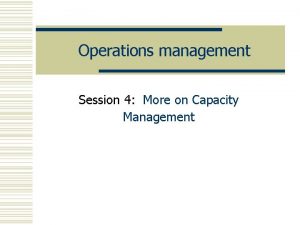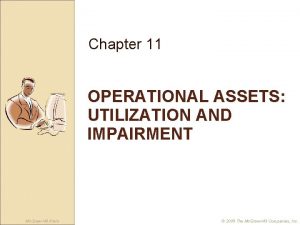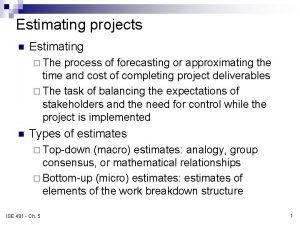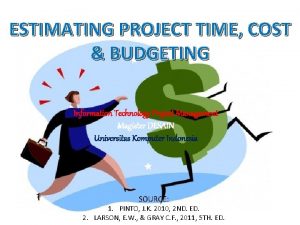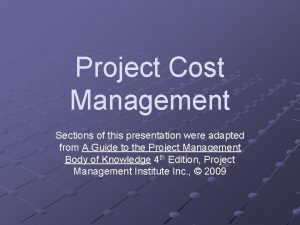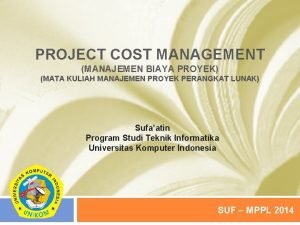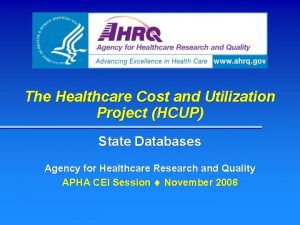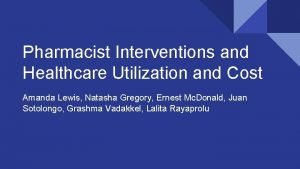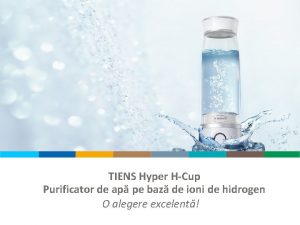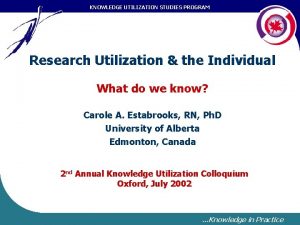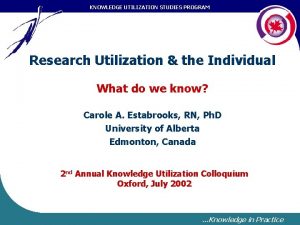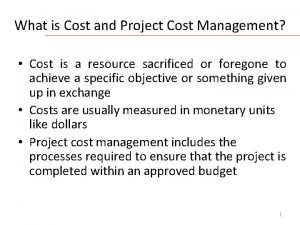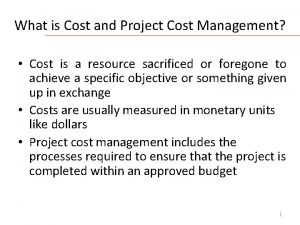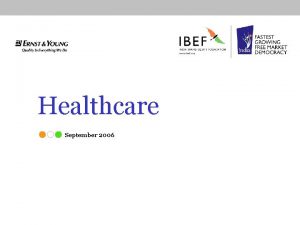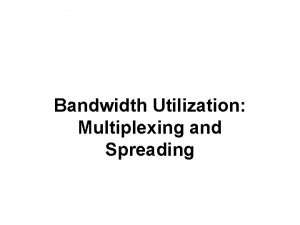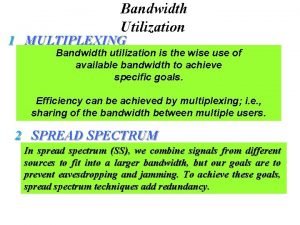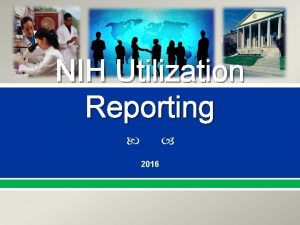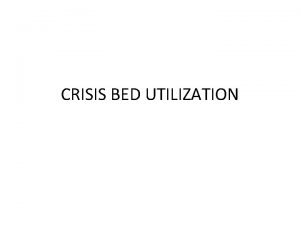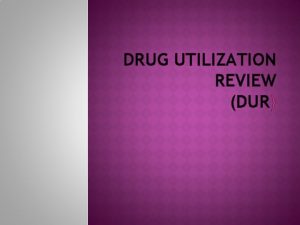Healthcare Cost and Utilization Project HCUP A Research












































































- Slides: 76

® Healthcare Cost and Utilization Project (H-CUP) A Research Tool Ali Seifi, MD , FACP Assistant Professor Departments of Neurosurgery, Neurology and Medicine University of Texas Health Science Center at San Antonio

® • • 2 Overview of H-CUP Application of HCUP in Clinical Research Current articles in Medicine Practice example

® What is H-CUP? n HCUP includes the LARGEST collection of multi-year hospital care (inpatient, outpatient, and emergency department) data in the United States, with all-payer, encounter-level information beginning in 1988. 3

® • The NIS is drawn from all States participating in HCUP, representing more than 95 percent of the U. S. population. 4

® • The NIS approximates a 20 -percent stratified sample of discharges from U. S. community hospitals, excluding rehabilitation and long-term acute care hospitals. 5

® • Primary and secondary diagnoses and procedures • Patient demographic characteristics (e. g. , sex, age, race, median household income for ZIP Code) • Hospital characteristics (e. g. , ownership) • Expected payment source • Total charges • Discharge status • Length of stay • Severity and comorbidity measures 6

H-CUP ® HCUP Databases SID SASD SEDD NEDS NIS 7 KID Research Tools Research Publications User Support

® Topic 8 What can you get from HCUP? Specific Findings Cost Septicemia was the most expensive reason for hospitalization in 2010—totaling nearly $18 billion in aggregate hospital costs (NIS) Access Americans in low-income areas visit EDs at rates 90 percent higher compared to those in the highest income areas (NEDS) Quality Oregon and Vermont had the Nation's lowest rates of avoidable hospitalizations for asthma in children ages 2 to 17 (PQI software, SID) Utilization Patients in rural hospitals were older (42 percent were 65 plus) than those in urban public hospitals (23 percent were 65 plus). (NIS)

® 9 HCUP Supports High Impact Health Services, Policy & Clinical Research

What is the Agency for Healthcare Research and Quality (AHRQ)? • • 10 The Agency for Healthcare Research and Quality (AHRQ) is a federal agency under the Department of Health and Human Services. The 2015 budget for AHRQ : $440 million.

® Texas: Bruce Burns Manager Texas Health Care Information Collection DSHS - Center for Health Statistics Mail Code - 1898 Department of State Health Services 1100 W. 49 th Street, M - 628 Austin, TX 78714 -9909 Phone: (512) 776 -6431 Fax: (512) 776 -7740 E-mail: bruce. burns@dshs. state. tx. us Web site: http: //www. dshs. state. tx. us/thcic/ 11

HCUP Has Six Types of Databases • Three state-level databases State Inpatient Databases State Ambulatory Surgery Databases (SID) (SASD) State Emergency Department Databases (SEDD) 12

HCUP Has Six Types of Databases • Three nationwide databases Nationwide Inpatient Sample (NIS) Nationwide Emergency Department Sample (NEDS) 13 Kids’ Inpatient Database (KID)

® 14

® 15

® The Foundation of HCUP Data is Hospital Billing Data Demographic Data Diagnoses Procedures Charges 16

® The Making of HCUP Data Billing record created Patient enters hospital AHRQ standardizes data to create uniform HCUP databases 17 States store data in varying formats Hospital sends billing data and any additional data elements to data organizations

® Where Do We Get HCUP Data? 14% (N=769) Typically not included in HCUP data is mostly from community hospitals 86% (N=4, 985) Included in HCUP data 18 Source: American Hospital Association (AHA), 2010

® What Are Community Hospitals? American Hospital Association Definition: Non-Federal, short-term, general, and other specialty hospitals, excluding hospital units of other institutions (e. g. , prisons) Included Excluded Multi-specialty general hospitals Long-term care OB-GYN Psychiatric ENT Alcoholism/Chemical dependency Orthopedic Rehabilitation Pediatric Do. D / VA / IHS Public Academic medical centers 19

® What Data Elements are included in the HCUP databases? Data Elements: 20 • Patient demographics (age, sex) • Diagnoses & procedures • Expected payer • Length of stay • Patient disposition • Admission source & type • Admission month • Weekend admission

® 21 Some Data Elements Vary by State • Race/Ethnicity • Physician identifiers encrypted • Patient county • Physician specialty • Patient ZIP Code • Hospital identifier unencrypted • Severity of illness • Birthweight • Procedure date (days from admission) • Primary payer details • Secondary payer • Detailed charges • Patient identifiers encrypted AK

NIS is a Stratified Sample of Hospitals from the SID State Inpatient Databases (SID) N = ~ 5 K hospitals ~ 36 M records Nationwide Impatient Sample (NIS) 5 NIS Strata 1. 2. 3. 4. 5. U. S. Region Urban/Rural Teaching Status Ownership/Control Bed Size Stratified Sample of HOSPITALS N = ~ 1 K hospitals ~ 8 M records 100% of all discharges from each hospital

® What is HCUP and What Is It Not? HCUP is… HCUP is NOT… Discharge database for health care A survey encounters 23 All payer, including the uninsured Specific to a single payer, e. g. Medicare Hospital, ambulatory surgery, emergency department data Office visits, pharmacy, laboratory, radiology All hospital discharges Only a sample Accessible multiple ways: raw data, regular reports, online Just another database

® Hospital Billing Data Have Benefits and Limitations Benefits Limitations Large number of visit records Differences in coding across hospitals Uniformity of coding Limited clinical details Routine, regular collection Lack revenue information Ease of access May not include all hospitals All-payer May not show complete experience of care Available at local, state, regional and national level No data on individuals outside of hospital system Supplemental files available to facilitate research 24

® Clinical Classifications Software (CCS) n Clusters diagnosis and procedure codes into categories n >12, 000 diagnosis codes ~260 categories n > 4, 000 procedure codes ~230 categories n Useful for presenting descriptive statistics, understanding patterns ICD-9 -CM Codes CCS for ICD-9 -CM 25 CCS Categories 0031 0202 0223 0362 0380 03810 03811 03819 0382 0383 03840 03841 03842 03843 03844 03849 0388 0389 0545 449 7907 CCS 2: Septicemia 0700 0701 07020 07021 07022 07023 07030 07031 07032 07033 07041 07042 07043 07044 07049 CCS 6: Hepatitis

® • Comorbidity Software Creates and appends indicator flags to each record for 29 major comorbidities ICD-9 -CM Codes, DRGs on Administrative Data 26 Comorbidity Software 29 Comorbidity Groups CHF Valvular disease Pulm circ disorders Peripheral vascular dx Hypertension Paralysis Other neuro disorders Chronic pulmonary dx DM w/o complications DM w/ complications Hypothyroidism Renal failure Liver disease …

® 27 http: //hcup. ahrq. gov/hcup. net

® H-CUP PUBLISHED ARTICLES IN MEDICAL SCIENCE 28

® 29

® 30

® 31

® 32

® 33

® Figure 1. Estimated number of cases of TC increases every year. Anum S. Minhas, Andrew B. Hughey, Theodore J. Kolias Nationwide Trends in Reported Incidence of Takotsubo Cardiomyopathy from 2006 to 2012 The American Journal of Cardiology, Volume 116, Issue 7, 2015, 1128– 1131 http: //dx. doi. org/10. 1016/j. amjcard. 2015. 06. 042

® Figure 2. Estimated number of cases of TC is highest among the 65 to 84 and 45 to 64 year age groups in each year. Anum S. Minhas, Andrew B. Hughey, Theodore J. Kolias Nationwide Trends in Reported Incidence of Takotsubo Cardiomyopathy from 2006 to 2012 The American Journal of Cardiology, Volume 116, Issue 7, 2015, 1128– 1131 http: //dx. doi. org/10. 1016/j. amjcard. 2015. 06. 042

® Figure 3. Estimated number of cases is higher among women than men in each year. Anum S. Minhas, Andrew B. Hughey, Theodore J. Kolias Nationwide Trends in Reported Incidence of Takotsubo Cardiomyopathy from 2006 to 2012 The American Journal of Cardiology, Volume 116, Issue 7, 2015, 1128– 1131 http: //dx. doi. org/10. 1016/j. amjcard. 2015. 06. 042

® 37

® • Use of IONM , ICD 9 -code 00. 94 was compared over time and between geographic regions Ø # 443, 194 spine procedures , Ø # 31, 680 IONM cases in 2007 to 2011. 38

® • Iatrogenic nerve and spinal cord injury were rare; they occurred in less than 1% of patients and did not significantly decrease when IONM was used. 39

® 40

® 41

Table 1. ICD codes. ® Seifi A, , et al. (2014) The Incidence and Risk Factors of Associated Acute Myocardial Infarction (AMI) in Acute Cerebral Ischemic (ACI) Events in the United States. PLo. S ONE 9(8): e 105785. doi: 10. 1371/journal. pone. 0105785 http: //127. 0. 0. 1: 8081/plosone/article? id=info: doi/10. 1371/journal. pone. 0105785

• During 10 years the NIS recorded 886, 094 Stroke admissions with 17, 526 diagnoses of AMI (1. 98%). • In-hospital mortality was associated with: AMI (a. OR 3. 68; 95% CI 3. 49– 3. 88, p≤ 0. 0001), Ø r. TPA administration (a. OR 2. 39 CI, 2. 11– 2. 71, p<0. 0001), Ø older age (a. OR 1. 03, 95% CI, 1. 03– 1. 03, P<0. 0001) Ø women (a. OR 1. 06, 95% CI 1. 03– 1. 08, P<0. 0001). Ø The Incidence and Risk Factors of Associated Acute Myocardial Infarction (AMI) in Acute Cerebral Ischemic (ACI) Events in the United States Seifi A, et al. (2014) The Incidence and Risk Factors of Associated Acute Myocardial Infarction (AMI) in Acute Cerebral Ischemic (ACI) Events in the United States. PLo. S ONE 9(8): e 105785. doi: 10. 1371/journal. pone. 0105785

Increased risk of associated AMI in patients treated with IV r. TPA. ® Seifi A, , et al. (2014). The Incidence and Risk Factors of Associated Acute Myocardial Infarction (AMI) in Acute Cerebral Ischemic (ACI) Events in the United States. PLo. S ONE 9(8): e 105785. doi: 10. 1371/journal. pone. 0105785 http: //127. 0. 0. 1: 8081/plosone/article? id=info: doi/10. 1371/journal. pone. 0105785

Annual mortality: Inpatients admitted with Stroke ® Seifi A, et al. (2014) The Incidence and Risk Factors of Associated Acute Myocardial Infarction (AMI) in Acute Cerebral Ischemic (ACI) Events in the United States. PLo. S ONE 9(8): e 105785. doi: 10. 1371/journal. pone. 0105785 http: //127. 0. 0. 1: 8081/plosone/article? id=info: doi/10. 1371/journal. pone. 0105785

Multivariate analysis predicting the odds of mortality. ® Seifi A, et al. (2014) The Incidence and Risk Factors of Associated Acute Myocardial Infarction (AMI) in Acute Cerebral Ischemic (ACI) Events in the United States. PLo. S ONE 9(8): e 105785. doi: 10. 1371/journal. pone. 0105785 http: //127. 0. 0. 1: 8081/plosone/article? id=info: doi/10. 1371/journal. pone. 0105785

Multivariate regression analysis predicting odds of having associated AMI. ® Seifi A, et al. (2014) The Incidence and Risk Factors of Associated Acute Myocardial Infarction (AMI) in Acute Cerebral Ischemic (ACI) Events in the United States. PLo. S ONE 9(8): e 105785. doi: 10. 1371/journal. pone. 0105785 http: //127. 0. 0. 1: 8081/plosone/article? id=info: doi/10. 1371/journal. pone. 0105785

Figure 3. Kaplan-Meier survival analysis with and without AMI. ® Seifi A, et al. (2014) The Incidence and Risk Factors of Associated Acute Myocardial Infarction (AMI) in Acute Cerebral Ischemic (ACI) Events in the United States. PLo. S ONE 9(8): e 105785. doi: 10. 1371/journal. pone. 0105785 http: //127. 0. 0. 1: 8081/plosone/article? id=info: doi/10. 1371/journal. pone. 0105785

® 49

® • There was an increase in the incidence of TBI among SCI admission from 3. 7% (1988) to 12. 5% (2008) (OR = 1. 067 per year; 95% CI = 1. 065– 1. 069 per year; P < 0. 0001). • Concurrently, SCI patients had an increase in TBI (9. 1% (1988)– 15. 9% (2008) (OR=1. 038 per year (95% CI 1. 036– 1. 040; P < 0. 001). 50

® Longitudinal incidence and concurrence rates for traumatic brain injury and spine injury – A twenty year analysis Fig. 2 Twenty year (1988– 2008) trend in the proportionate concurrence of TBI and SCI.

® Fig. 1 Twenty year (1988– 2008) trend in the incidence of TBI and SCI per 100 k determined from the Nationwide Inpatient Sample.

® 53

® During the period 2003– 2011, # 18, 260 recorded repaired SAH : Ø Ø 54 9737 (53. 32%) underwent endovascular coiling and 8523 (46. 48%) had surgical clipping.

® # 131 patients in the cohort with reported Dissection Patients who underwent endovascular coiling had a higher rate of Dissection in this cohort (OR 2. 94; 95% CI 2. 00 to 4. 31, p<0. 0001). 55

® Incidence of the use of treatment modalities (endovascular coiling, surgical clipping) as a fraction of subarachnoid hemorrhage all comers, 2003– 2011. Carr K et al. J Neuro. Intervent Surg doi: 10. 1136/neurintsurg Copyright © Society of Neuro. Interventional Surgery. All rights reserved. -2014 -011324

® Annual rate of reported dissection in SAH based on treatment option

® Incidence of craniocervical arterial dissections (CCADs) in the study cohort. Carr K et al. J Neuro. Intervent Surg doi: 10. 1136/neurintsurg -2014 -011324 Copyright © Society of Neuro. Interventional Surgery. All rights reserved.

® 59

® Conclusions • Stroke patients undergoing thrombectomy who were admitted to Nonteaching hospitals on weekends were more likely to be discharged with moderate-to-severe disability than those admitted on weekdays. • No weekend effect on discharge clinical outcome was seen in Teaching hospitals. 60

® 61

® 62

® Ø Multivariate analysis demonstrated : 63 ØSignificantly higher complication risk in Teaching institutions (OR 1. 33 [95% CI 1. 11– 1. 59], p = 0. 0022) ØNo significant change in Nonteaching hospitals (OR 1. 11 [95% CI 0. 91– 1. 37], p = 0. 31).

® 64

® 65

® 66

® 67

® 68

® 69

® 70

® AANS , Washington, 2015 Impact of Payment Source on Craniotomy Mortality in the United States During 2000 -2011 Meagan Keefe*, Katrin Eurich*, Bradley Dengler MD**, Ali Seifi MD, FACP** *School of Medicine and **Department of Neurosurgery, University of Texas Health Science Center at San Antonio

Mortality Rate per 1000 Hospital Admissions ® Craniotomy Mortality Rates by Payment Type, 2000 -2011 180. 000 Private insurance 160. 000 140. 000 Medicare 120. 000 100. 000 80. 000 Medicaid 60. 000 40. 000 200020012002200320042005200620072008200920102011 Uninsured / selfpay / no charge

Mortality Rate per 1000 Hopsital Admissions ® Craniotomy Mortality Rates by Income, 2000 -2011 120. 000 100. 000 80. 000 60. 000 40. 000 200020012002200320042005200620072008200920102011 1 st (Lowest) Income Quartile 2 nd Income Quartile 3 rd Income Quartile 4 th (Highest) Income Quartile

Poster #: 32369 AANS , Washington 2015 Title: Impact of Resident Duty-Hour Restrictions on Mortality of Nervous System Disease and Disorder Ian Churnin, BS*; Kevin Carr, MD**; David Jimenez, MD**; Joel Michalek, Ph. D***; John Flynn, BS*; Ali Seifi, MD, FACP** *School of Medicine and **Department of Neurosurgery, University of Texas Health Science Center at San Antonio, Texas

Figure 1. Nervous System Disease/Disorder Mortality by Hospital Teaching Status 6% 5% Mortality 4% 3% 2% Teaching 1% Non-Teaching 0% 2000 2001 2002 2003 2004 2005 Year 2006 2007 2008 2009 2010

® Questions/Comments? Time for Questions and/or Comments. 76 Reference: http: //www. ahrq. gov/research/data/hcup /index. html
 Healthcare utilization project
Healthcare utilization project Healthcare utilization project
Healthcare utilization project Healthcare and the healthcare team chapter 2
Healthcare and the healthcare team chapter 2 Sports medicine meaning
Sports medicine meaning Cost control and cost reduction project report
Cost control and cost reduction project report Cost control and cost reduction project report
Cost control and cost reduction project report The resource requirements plan illustrates
The resource requirements plan illustrates Research utilization process steps
Research utilization process steps Define research utilization
Define research utilization What are four objectives of warehouse operation?
What are four objectives of warehouse operation? Multilevel multiplexing
Multilevel multiplexing Bandwidth utilization multiplexing and spreading
Bandwidth utilization multiplexing and spreading Va office of small and disadvantaged business utilization
Va office of small and disadvantaged business utilization Link utilization in stop and wait
Link utilization in stop and wait What is multiplexer
What is multiplexer Healthcare project management kathy schwalbe
Healthcare project management kathy schwalbe Advancing healthcare research
Advancing healthcare research Cost accumulation and cost assignment
Cost accumulation and cost assignment Cost accumulation and cost assignment
Cost accumulation and cost assignment Cost accumulation and cost assignment
Cost accumulation and cost assignment What is a period cost on the income statement
What is a period cost on the income statement Cost control and cost reduction difference
Cost control and cost reduction difference Standard cost is
Standard cost is Distinguish between average cost and marginal cost
Distinguish between average cost and marginal cost Cost control and cost reduction difference
Cost control and cost reduction difference Process costing vs job order costing
Process costing vs job order costing Ordering cost and carrying cost
Ordering cost and carrying cost Actual cost and opportunity cost
Actual cost and opportunity cost Cost behavior patterns
Cost behavior patterns Utilization law
Utilization law Performance parameters of half wave rectifier
Performance parameters of half wave rectifier Packet utilization standard
Packet utilization standard Trailer cube utilization
Trailer cube utilization Citrate utilization test
Citrate utilization test Citrate utilization test procedure
Citrate utilization test procedure Tsi test: principle
Tsi test: principle Energy definition
Energy definition Drug utilization evaluation template
Drug utilization evaluation template Data utilization strategies
Data utilization strategies Asset utilization formula
Asset utilization formula Capacity chunks in operations management
Capacity chunks in operations management Layout
Layout Design capacity example
Design capacity example Urease test
Urease test Asset utilization analysis
Asset utilization analysis Basic unit of cpu utilization
Basic unit of cpu utilization Plant utilization factor
Plant utilization factor Bottleneck utilization
Bottleneck utilization Cpu utilization factor
Cpu utilization factor Unit hour utilization formula
Unit hour utilization formula Medication utilization evaluation
Medication utilization evaluation Oats amino acid profile
Oats amino acid profile Factors affecting chronaxie
Factors affecting chronaxie Media
Media Utilization factor
Utilization factor Motor equipment utilization record
Motor equipment utilization record Code cave utilization
Code cave utilization Farooq ghani
Farooq ghani Nitrate utilization test
Nitrate utilization test Utilization rate operations management
Utilization rate operations management Assets utilization
Assets utilization Cisco bandwidth utilization calculation
Cisco bandwidth utilization calculation Manufacturing cost vs non manufacturing cost
Manufacturing cost vs non manufacturing cost Job costing vs process costing
Job costing vs process costing Wacc example
Wacc example Manufacturing cost vs non manufacturing cost
Manufacturing cost vs non manufacturing cost Manufacturing cost vs non manufacturing cost
Manufacturing cost vs non manufacturing cost Manufacturing variance analysis
Manufacturing variance analysis Flotation cost in cost of equity
Flotation cost in cost of equity Literal cost gate input cost
Literal cost gate input cost Literal cost gate input cost
Literal cost gate input cost Literal cost gate input cost
Literal cost gate input cost Estimating project time and cost
Estimating project time and cost Estimating project time and cost
Estimating project time and cost Estimating project time and cost
Estimating project time and cost Cost management presentation
Cost management presentation Contoh cost control
Contoh cost control
